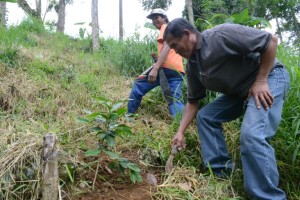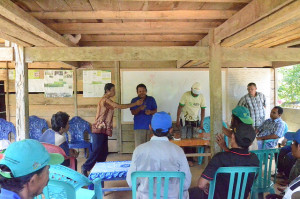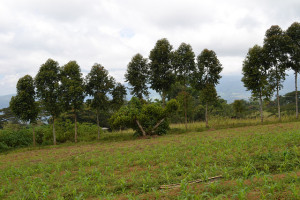
By Amy Cruz, adapted from ICRAF’s Agroforestry World Blog
Despite impressive economic growth in Asia and the Pacific, the region still has to address the food insecurity of over half a billion of its people. Climate-smart agriculture (CSA), including agroforestry and other diversified farming practices, has huge potential to improve food security and address climate change at the same time. At a Forum, organized by the Asian Development Bank in June 2016 in the Philippines, researchers, policymakers and farmers discussed what should be done to expand such practices and bring greater benefits to more people. Amy Cruz, Communication officer with the World Agroforestry Centre, followed the discussions. This is part 2 of a CSA special, read part 1 here.
Various studies in Southeast Asia by the World Agroforestry Centre (ICRAF) (see Agroforests expanding across landscapes in Northwest Viet Nam, Agroforestry having an impact on farmers in eastern Indonesia, Farms with trees and crops recover quicker from natural disasters, Which agroforest for which farm under changing climates?) have shown that integrating trees on farms has multiple benefits, including securing food supply in the face of climate extremes. But for a greater number of people to benefit, such practices must be scaled up.
But can the world’s farmers and governments successfully expand climate-smart agriculture and agroforestry? To understand how this can be done, the Asian Development Bank organized the Food Security Forum: Safe, Nutritious, and Affordable Food for All, 22–24 June 2016 in Manila, Philippines.
Landscape thinking and CSA
It became clear at the Forum that people’s mindsets need to change if climate-smart agriculture shall be expanded. From looking at the management of the environment and natural resources separately, people have to shift to seeing whole landscapes.

Looking at the whole the landscape rather than at individual farms or groups of trees or livestock would help people appreciate the potential of climate-smart agriculture practices, such as agroforestry, to integrate not only crops but also farms, communities and whole ecosystems. This approach plays a key role for the CGIAR Research Program on Forests, Trees and Agroforestry because it addresses multiple challenges in a holistic way.
Landscape management can protect local and indigenous communities and can provide food, fuel and incomes. These benefits are recognized by more and more governments and communities worldwide.
One example comes from the coastal villages in the municipality of Guinayangan in the Philippines, which have started rehabilitating mangrove systems in their areas through a project supported by the CGIAR Research Program on Climate Change, Agriculture and Food Security. Fishers say these mangroves help improve their livelihoods and at the same time protect their communities from storms.
ICRAF researchers have also been promoting integrated agroforestry systems, which include mangroves, to connect coastal communities to lowland and upland communities. Such integrated systems view communities and livelihoods as part of a landscape that extends from ridge to reef.
Aside from protection and fast recovery from natural disasters, integrated agroforestry systems can also be sources of biofuel and feed for livestock.
CSA needs communication

Increasing farmers’ awareness of the benefits of trees and integrated systems is one way of expanding the scale of such beneficial strategies. This could be achieved if governments and donors supported communication projects connecting farmers with researchers and agricultural advisory services.
Integrated landscape management wasn’t the only thing emphasized during the Forum. Takehiko Nakao, President of the Asian Development Bank, highlighted the social and political dimensions of food security. Policies that support communities also help increase inclusiveness, which then increases the likelihood that farmers will adopt climate-smart agriculture.
Sunny Verghese, executive director of Olam International Limited, Singapore, said public-private-plural society partnerships should also be prioritized. Collaboration between organizations can connect communities to those who can help them tackle food security and climate change. Improved information sharing, whether it is farmer-to-farmer, farmer-to-extension or development worker or farmer-to-policymaker, is crucial in such collaborations.
Learning farms
One example of successful information sharing to expand the scale of climate-smart agriculture is the ‘learning farm’ initiative of JonJon Sarmiento, known online as Farmer Jon. He is the sustainable agriculture program manager of the Pambansang Kilusan ng mga Samahang Magsasaka (PAKISAMA), a national farmers’ federation in the Philippines, which helps farmers to set up ‘learning farms’.
Guided by plans they develop themselves in training sessions, the farmers employ climate-smart agricultural practices and become ‘farmer technicians’. Their ‘learning’ farms are visited by other farmers who can see how these practices actually work.
This way, a ripple effect could be created so that more and more farmers adopt these innovative practices. Having multiple learning sites in a certain area could then lead to establishing ‘learning communities’: groups of villages that implement different climate-smart and integrated farming practices.
In the municipality of Lantapan in the southern Philippines, ICRAF has been building the capacity of upland communities to establish agroforests and other climate-smart practices that not only help people adapt to climate change but also allow the watershed to provide more water for irrigation. The research team is now looking to connect the farmers with private and public groups that could help them implement such systems through ‘co-investment’ schemes.













